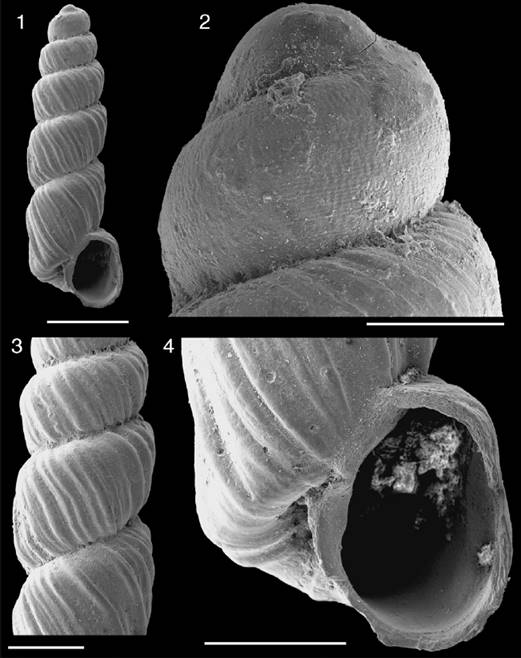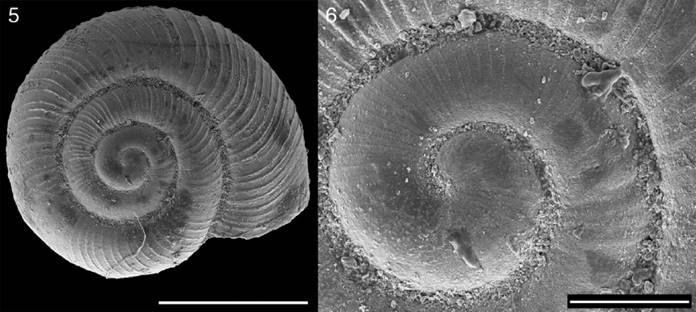Most of the almost 160 species of terrestrial mollusks found in Chile are distributed in the humid central and southern areas of the country, and especially in the Juan Fernández Archipelago (Miquel and Araya, 2015, Stuardo and Vega, 1985). Studies on the species from the very arid north of Chile are scarcer and only a few recent studies have documented the unexpected diversity of land snails found in the area, including the description and record of new species of bulimulid and charopid snails (Araya, 2015, Araya et al., 2016). In the present work, based on a small collection of specimens from coastal areas of the very arid Región de Antofagasta, in northern Chile, we present new records of a rare bulimulid, a pupillid and 2 charopid species, one of them unidentified. Thus, the aim of this work is to contribute to the knowledge of the land snail fauna in Chile, particularly from the neglected northern part of the country. Voucher specimens were deposited at the Invertebrate Collection of the Museo Argentino de Ciencias Naturales “Bernardino Rivadavia”, Buenos Aires, Argentina (MACN-In).
Family Bulimulidae Tryon, 1867
Bostryx holostoma (Pfeiffer, 1846) (Figs. 1-4)

Figures 1-4 Bostryx holostoma (Pfeiffer, 1846), Antofagasta, Chile (MACN-In 39.685); (1): apertural view; (2): detail of protoconch sculpture; (3): detail of ribs on teleoconch; (4): detail of aperture. Bar = 2 mm for 1, 0.5 mm for 2, and 1 mm for 3 and 4.
Material examined: foothills of Cerro Bolfín (23°49′59″ S, 70°28′59″ W; 620 m), Comuna de Antofagasta, Región de Antofagasta, Chile; 4 specimens, collected by E. Martínez, 1982 (MACN-In 39.685).
Distribution: this endemic species has been previously recorded only at Cobija, Región de Antofagasta (22°33′ S, 70°16′ W), Chile (Stuardo & Vega, 1985). This is the first record of the species since Pilsbry (1897), representing also its southernmost record.
Remarks: this is the smallest Bostryx species found in Chile, and it is clearly identified from other congeneric species by the sculpture of strong axial ribs, which are irregularly present in the teleoconch and the slightly plane whorls, ending in a slightly square-shaped aperture (Pilsbry, 1897). The presence of a noticeable spiral sculpture on the protoconch is unique among the Chilean Bostryx species, which otherwise present a smooth protoconch (without sculpture) even under magnification (Araya, 2015).
Family Charopidae Hutton, 1884
Stephacharopa calderaensisMiquel & Araya, 2013 (Figs. 5, 6)

Figures 5-6 Stephacharopa calderaensisMiquel & Araya, 2013, Antofagasta, Chile (MACN-In 39.800); (5): apical view; (6): detail of protoconch. Bar = 1 mm for 5, and 0.2 mm for 6.
Material examined: foothills of Cerro Bolfín (23°49′59″ S, 70°28′59″ W; 620 m), Comuna de Antofagasta, Región de Antofagasta, Chile; 2 specimens, collected by E. Martínez, 1982 (MACN-In 39.800).
Distribution: this species has a patchy distribution; it has been found only in 2 locations in the hills of the Chilean Coastal Range at the vicinities of the port of Caldera, Región de Atacama, Chile (Araya and Catalán, 2014, Miquel and Araya, 2013). This is the northernmost record for the species, extending its geographical distribution by about 350 km.
Remarks: this is the northernmost charopid species found in the country.

Figures 7-9 Charopidae sp., Antofagasta, Chile (MACN-In 39.799); (7): umbilical view; (8): detail of umbilicum. Pupoides minimus (Philippi, 1860), Antofagasta, Chile (MACN-In 39.801); (9): apertural view. Bar = 2 mm for 7, 0.1 mm for 8, and 1 mm for 9.
Material examined: foothills of Cerro Bolfín (23°49′59″ S, 70°28′59″ W; 620 m), Comuna de Antofagasta, Región de Antofagasta, Chile; 1 specimen, collected by E. Martínez, 1982 (MACN-In 39.799).
Remarks: none of the Chilean charopid species match the characteristics of the present specimen, which includes a smooth protoconch and teleoconch and a rather large size for a Chilean charopid (6 mm in diameter). A species similar to the present examined specimen is the enigmatic Helix paupera described by Philippi for the coast of Atacama, which has a smaller shell (Philippi, 1860: 164).
Family Pupillidae Turton, 1831
Pupoides (Ischnopupoides) minimus (Philippi, 1860) (Figure 9)
Material examined: Foothills of Cerro Bolfín (23°49′59″ S, 70°28′59″ W; 620 m), Comuna de Antofagasta, región de Antofagasta, Chile; 6 specimens, collected by E. Martínez, 1982 (MACN-In 39.801).
Distribution: this species, one of the 2 pupillid species found in the country, has been found from Antofagasta to La Serena, usually in coastal localities, buried in sand and humus (Stuardo & Vargas-Almonacid, 2000).
Remarks: this is the smallest elongate land snail found in the country, with minute shells rarely over 4 mm in height. Some differences between the examined material and southern material may indicate that more than one species may be present in northern Chile.
Most of the northern areas of the country have been very sparsely studied in regard to their invertebrate fauna, and terrestrial mollusks are one of the least represented groups. The present records, even when meager, add important information on the distribution of these species in the very arid Región de Antofagasta. The only zones which have permanent vegetation —most of them endemic xerophytic plants, also with restricted distributions— are the coastal areas limited by the Chilean Coastal Range, which receive morning fogs from the sea. The unexpected occurrence of Stephacharopa calderaensis, and of an unidentified charopid species, represent the northernmost distribution in Chile of the family Charopidae, a family of terrestrial micro snails mostly found in humus in humid circumstances (Solem, 1983). Its current distribution in northern and central Chile is essentially restricted to rocky outcrops, as litho-refugia sensuCouper and Hoskin (2008), and it is possible that these species may represent part of a more humid relict fauna (Araya, 2016, Craig, 1985, Herm, 1970).
In summary, new records of land snails in northern Chile are presented, including the first collection of Bostryx holostoma since its description. Further research in northern Chile, especially of humus and sediment samples, is essential to document this neglected fauna.
We are thankful to the anonymous reviewers and the associate editor for their valuable comments and suggestions, which greatly improved this manuscript.











 nova página do texto(beta)
nova página do texto(beta)


